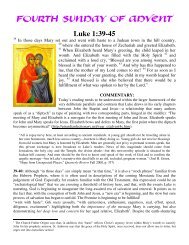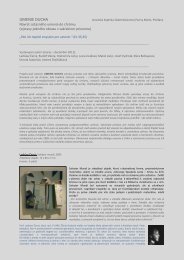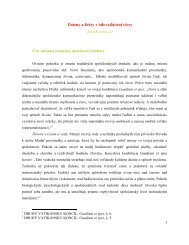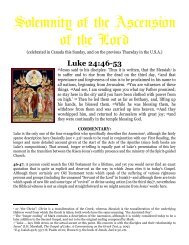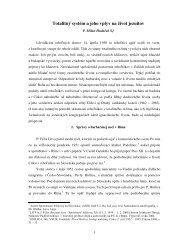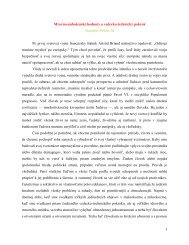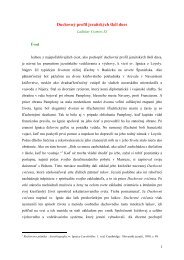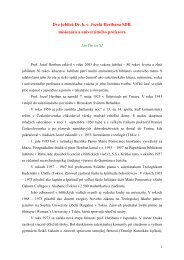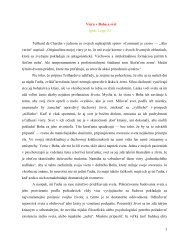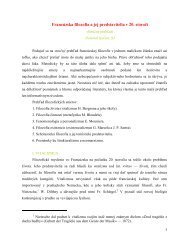Luke 16:19-31 - Jezuiti
Luke 16:19-31 - Jezuiti
Luke 16:19-31 - Jezuiti
Create successful ePaper yourself
Turn your PDF publications into a flip-book with our unique Google optimized e-Paper software.
The Iliad makes numerous references to garments of purple worn by kings and generals. In the<br />
Odyssey, the hero, Odysseus, is given a cloak dyed sea purple by his wife Penelope. Purple robes<br />
were deemed worthy offerings to Apollo at Delphi by King Croesus of Lydia, according to<br />
Herodotus. The poetry of Sappho relates the high esteem of purple garments as gifts for gods and<br />
goddesses. Greek lyric poets of the 5 th century BC equated purple with the garments of heroes and<br />
gods … In the Classical and Hellenistic periods, purple enjoyed a sacrosanct and noble status,<br />
adorning distinguished people. It was common, therefore, for statesmen, actors, courtesans and<br />
wealthy citizens to wear purple as a rather blatant show of power and status … [In Roman society,]<br />
purple stripes were worn on the togas of officials, and eventually became the privilege of senators.<br />
(Virginia M. Da Costa, “Purple,” in Nigel Guy Wilson, ed. Encyclopedia of Ancient Greece , p. 615)<br />
The market in purple dye was so lucrative that many unscrupulous individuals would offer inferior dyes,<br />
in an attempt to “cash in” on the demand: “The demand for purple exceeded its supply, and in the ancient<br />
world, cheaper and more plentiful substitutes were developed, by diluting the true organic dye with water,<br />
urine or honey, or by using animal or vegetable material that approximated to the desired color … There<br />
were industries devoted to the production of counterfeit purple from cheap materials such as mulberry<br />
juice, amaranth blossoms and crushed bloodstone.” (Da Costa, “Purple,” p. 615).<br />
Fine linen was often used for the undergarments of the wealthier classes. The type referred to here,<br />
byssus, was probably a superior-quality linen imported from Egypt—highlighting once again the man’s<br />
wealth, since he was able to purchase such luxury goods.<br />
Note that, by comparison, there is no mention made of Lazarus’ clothing—if, indeed, he had anything but<br />
rags to wear.<br />
“feasted sumptuously every day”: <strong>Luke</strong> highlights the ostentation and lavishness of the rich man’s meals.<br />
20: “at his gate lay a poor man named Lazarus”: “The opening scene provides a brief social description of<br />
the two men. They are two very different men in an essentially two-tier society of ‘haves’ and ‘have-nots’ …<br />
The fact that there is a ‘gate’ at which Lazarus lay means that the rich man lives in a mansion surrounded<br />
by a wall, designed to keep the ‘have-nots’ at a distance. The wall and its gate make a statement. Although<br />
he may well be aware that poverty surrounds him, the rich man does not want to see it, or do anything to<br />
alleviate it.” (Arland J. Hultgren, The Parables of Jesus: A Commentary, p. 112).<br />
Lazarus: this is likely a Greco-Latin form of an originally Semitic name, probably Eleazar, “God has<br />
helped [me]” or Eliezer, “My God is [my] helper” 2 . “The rich man is not portrayed as particularly wicked;<br />
he is simply not attentive to the situation (the poor man nearby). Nor is it said that Lazarus was<br />
particularly good; he simply has no help but God alone in this world. Since <strong>Luke</strong> commonly equates<br />
poverty and piety, however, Lazarus is most likely to be understood as pious, even as his name suggests.”<br />
(Hultgren, Parables, p. 112). Of course, given Lazarus’ situation, his name must have seemed like a cruel<br />
joke, since it seemed that God was not helping him, and was abandoning him to the mercy (lack of<br />
mercy?) of his fellow human beings. Historians suggest that perhaps 5% of any ancient city would have<br />
been made up of such beggars, who depended on the generosity and compassion of others to survive.<br />
“The wealthy man knew who the beggar was, because he would later recognize him after both their<br />
deaths. Meanwhile, day by day, as the man passed through his gate wearing his purple robes, his<br />
perfumed aroma collided with the beggar’s stench. Occasionally their eyes met, but with no recognition<br />
and no feeling by the wealthy man. The beggar was simply part of the landscape—an unpleasant sight one<br />
had to endure. Soon the beggar would be gone.” (R. Kent Hughes, <strong>Luke</strong>: That You May Know the Truth,<br />
p. 156)<br />
“Lazarus is … said to ‘lay’ (RSV, NEB, NRSV) at the gate, or it is said that he ‘was laid’ (KJV, NIV) there.<br />
The Greek verb is ἐβέβλητο [ebeblēto], the perfect passive of βάλλω [ballō], which is used to depict a<br />
person confined to his or her sickbed (cf. Matt. 8:6,14; 9:2; Mark 7:30). The use of the verb points to his<br />
2 Interestingly, this is the only time that a character in one of Jesus’ parables is given a name, highlighting that, both for<br />
Jesus and for <strong>Luke</strong>, this is apparently a particularly key parable.



